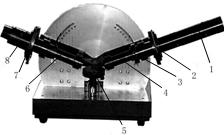
1. He-Ne laser
2. Polarizer
3. λ/4 wave plate
4. Incident tube
5. Sample stage
6. Output tube
7. Analyzer
8. Photocell
Features
Ideal for demonstration
Polarization by reflection
Refractive index measurement
Introduction
The LEOI-44 Experimental Ellipsometer is a manually operated demonstration tool designed to help students understand the principles and operation of ellipsometry. Ellipsometry is a technique used to measure the thickness and refractive index of thin films by analyzing changes in the polarization of light reflected from the film surface.
In this system, a randomly polarized input beam undergoes a series of polarization transformations before interacting with the sample. Specifically:
1. The input beam is first transformed into a linearly polarized beam through a polarizer.
2. The beam is then passed through a quarter-wave plate to convert it into an elliptically polarized beam.
3. Upon striking the sample, the polarization state of the reflected beam changes due to the interaction with the film surface.
By analyzing the change in the polarization of the reflected beam, students can calculate the thickness and refractive index of the film. This system provides an opportunity for students to develop a practical understanding of how an ellipsometer works and how it is used in material science and thin-film characterization.
The instruction manual contains comprehensive materials including experimental configurations, principles and step-by-step instructions. Please click Experiment Theory and Contents to find more information about this apparatus.
Specifications
| Description | Specifications |
| Thickness Measurement Range | 1 nm ~ 300 nm |
| Range of Incident Angle | 30º ~ 90º , Error ≤ 0.1º |
| Polarizer & Analyzer Intersection Angle | 0º ~ 180º |
| Disk Angular Scale | 2º per scale |
| Min. Reading of Vernier | 0.05º |
| Optical Center Height | 152 mm |
| Work Stage Diameter | Φ 50 mm |
| Overall Dimensions | 730x230x290 mm |
| Weight | Approximately 20 kg |
Part List
| Description | Qty |
| Ellipsometer Unit | 1 |
| He-Ne Laser | 1 |
| Photoelectric Amplifier | 1 |
| Photo Cell | 1 |
| Silica Film on Silicon Substrate | 1 |
| Analysis Software CD | 1 |
| Instruction Manual | 1 |

1. He-Ne laser
2. Polarizer
3. λ/4 wave plate
4. Incident tube
5. Sample stage
6. Output tube
7. Analyzer
8. Photocell